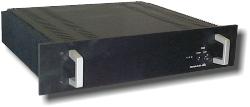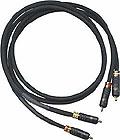![[SoundStage!]](../sslogo3.gif) Standout Systems Standout SystemsBack Issue Article |
| May 1999 The Affliction Being an audiophile, for me, has always been about music. If that sounds like a cliché, it’s likely because many audiophiles (and audio writers) constantly profess their love of music like a mantra: It’s about the music, It’s about the music, It’s about the music. Why is that? To my mind, the reason is simple: our hobby tends to bring out obsessive-compulsive tendencies in the vast majority of its (mostly male) members. It isn’t long after most of us first hear high-quality sound that we’re completely hooked, and not long after that when the disease audiophilia nervosa sets in. Is Lyle Lovett’s voice perfectly centered between the speakers? Are the sibilants in Holly Cole’s voice too aggressive, or is that just the recording? Is that really the saxophonist breathing during rests, or are my speakers chuffing during the double-bass solo? If this kind of neurosis is so common, then, why are do so many of us vehemently reject it? For many, denial is a coping mechanism, a way to try and return to that state where it really was about the music, when you were able to relax and simply enjoy your favorite tunes. For others that really have successfully conquered their affliction, it’s an expression of glee, of freedom. For me, audiophilia nervosa is an on-and-off struggle, often dependent on my stress level as much as on the equipment I have on hand. Recently, however, I amassed a system that contained items both owned personally by myself and loaned to me for review which helped me to cross the gap from obsession to relaxation, from being a lover of audio equipment to a lover of music. When listening to this system, I am far less concerned about soundstaging (though I’m always concerned about SoundStage!), accuracy, and clarity than with the sheer emotional joy of music. And all the equipment is within the reach of Joe Sixpack. It is my pleasure to share the details of this system with you. Old faithful In audio as in my day job, the proverb "Garbage In, Garbage Out" is highly applicable. If the sound produced by your front-end electronics doesn’t meet your needs, then no combination of megabuck preamps, amps, speakers, and wire will produce musical heaven. How, then, can you attain a great front-end on the cheap? Luckily, in the late 1990s you can find a plethora of very high-quality integrated CD players in the sub-$1000 price range. My particular poison is the Parasound C/DP-1000. At a retail price right around $500, this stalwart combines great sound and solid build without straining the pocketbook at all. I realize that most equipment that audiophiles consider "bargain-priced" is still in the stratosphere for the uninitiated. However, anyone making a good living who will not spend 5 C-notes on such a crucial piece of electronics is doomed to a life of putrid sound, and will receive no sympathy from me. The Parasound, with its lovely black metal case, has a solid heft and clean lines that will shame no one’s interior decorator. However, most importantly to me, its sound quality emphasizes the immense strides made in entry-level digital equipment since the early days of "Perfect Sound Forever." The C/DP-1000 combines a detailed presentation with excellent soundstaging and pacing. In fact, its speed and pacing were what finally sold me -- at the time, no player I auditioned near its price could match its uncanny ability to bring across the natural pace of the music I enjoy. In fact, I haven’t yet auditioned a digital front-end with sufficient quality to cause me to upgrade. Power and control
Despite my high-esteem for the Alternate Audio BCAP, this system leaves volume control and source selection to the McCormack TLC-1 linestage. Though a quite good performer when run as a buffered linestage, I prefer the TLC-1’s sound though its passive outputs. Run passively, the TLC-1 has enough transparency to complement the CA35 and pass on all nuances of the source component. Counter-intuitively, I actually even prefer the TLC-1’s bass when run passively -- it seems deeper, and more controlled. The double-edge sword of transparency, of course, is how it passes on both the jewels and flaws of source components. Luckily, the Parasound exhibits (to my ear) few of the evils of bargain digital equipment, and the transparency and slightly laid-back nature of the TLC-1/CA35 combo compliments the C/DP-1000’s forward tilt nicely. Output and connectivity
The simplicity of this system (one source, one
amplifier) requires very few interconnects, and that role is handled by the Kimber HERO,
terminated with WBT screw-down RCA connectors. The HERO’s dynamic presentation and
broad soundstaging put a smile on my face when I first picked them up, and continue to
bring a smile to The speaker cable situation is slightly more complex; as the Nova Audio Bravos are designed to be bi-wired, we can mix and match sonic characteristics to provide the best sound. For this system, I’ve been quite enraptured with the mix of JPS Labs Ultra Conductor speaker wire handling tweeter duties, with bass antics handed off to the capable Cardas TwinLink-A speaker cabling. To these ears, this combination provides the best mix of bass depth and control with non-smeared midrange and dynamic, yet unaggressive treble. Support equipment Despite my yearning for simplicity and disgust with complex, esoteric tweaks, I have to admit the importance provided by system tweaking in the final performance of a high-end system. To this end, this standout system relies on a number of supporting cast members, ranging in price from the moderate to the absurdly cheap. Source and control (in this case, CD and linestage) components rest on the Michael Green Designs Justarack, finished in natural cherry. The simple-yet-rigid construction of the Justarack, combined with the cherrywood shelving, combine good sound with great looks, in the best tradition of audio furniture. Sadly, the abuse of an often-times ham-fisted reviewer has left some stains (from equipment feet), scratches, and even chips in the rack’s attractive finish. However, it faithfully labors on. Amplifiers, however, no longer take their rightful place on the Justarack. They are delegated to perching on concrete paving stones purchased at my favorite local building center. Originally acquired as an attempt to tweak the performance of the homely-yet-delightful Ohm Walsh 100 loudspeakers, they have proved natural amplifier stands. Their solidity and rigidity nicely anchor heavy amplification equipment to the floor, and make swapping cables much simpler to boot. Indeed, a wild insight by my friend JP has led to another use for these famous paving stones. One rests underneath the Parasound CD player, which in turn rests on top of the Justarack. The seemingly innocuous introduction of this heavy, unattractive object greatly cleaned up the entire system’s sound, tightening bass response and dramatically zeroing-in the positioning of voices and instruments in the soundstage. Whether due to the mass-loading of the rack, anchoring of the CD/P-1000 to said rack, or some other effect, it’s both noticeable and greatly appreciated. System as a whole Assembling the above components provides a sound that is clean, clear, and detailed. In fact, I would go so far as to call it relaxing; with this system, I’ve enjoyed music more than at any other time since I moved into my new apartment, ironically, with its dedicated listening room. The only flaw? A bit of room-induced bass overemphasis. Over the next several months, I intend to pursue and eradicate this bloat, both through adjustment of speaker positioning and room tuning/tweaking. But even this isn’t enough to reduce the sheer musical enjoyment provided by this standout system. Simple, cheap, unassuming: all these words apply to this system, along with one other -- excellent. ...James Causey
|
|
![[SoundStage!]](../sslogo3.gif) All Contents All ContentsCopyright © 1999 SoundStage! All Rights Reserved |
 Amplification
duties in this standout system are handled by the Alternate Audio CA35. As I
indicated in my review of the CA35 and its cohort, the BCAP preamplifier, my horizons have
been broadened by this fully class-A amplifier. As a former adherent of the more-power
school, I was seduced by the CA35’s ability to strip away layers that separated me
from the musical experience. Despite its relatively low power output, the CA35 was
perfectly competent at producing enough volume to awaken the neighbors, drive out my cat,
and even damage my hearing, had it been allowed enough time to do so. And, much more
importantly, its detail and clarity allowed me to glean the musical nuances of most
performances at low and moderate levels without seeming to sacrifice dynamics. And the
CA35 was free of any annoying solid-state hash.
Amplification
duties in this standout system are handled by the Alternate Audio CA35. As I
indicated in my review of the CA35 and its cohort, the BCAP preamplifier, my horizons have
been broadened by this fully class-A amplifier. As a former adherent of the more-power
school, I was seduced by the CA35’s ability to strip away layers that separated me
from the musical experience. Despite its relatively low power output, the CA35 was
perfectly competent at producing enough volume to awaken the neighbors, drive out my cat,
and even damage my hearing, had it been allowed enough time to do so. And, much more
importantly, its detail and clarity allowed me to glean the musical nuances of most
performances at low and moderate levels without seeming to sacrifice dynamics. And the
CA35 was free of any annoying solid-state hash. Without loudspeakers, of
course, all the upstream electronics would be for naught. And this standout system has a
pair of standout speakers: the Nova Audio Bravos. As the lowest-priced loudspeaker
in Nova Audio’s corral, the Bravo has quite a family reputation to live up to.
Without scooping my upcoming review, let me just say that it does so outstandingly, with
an effortless, detailed presentation, broad soundstaging, and bass whose tightness and
depth belies its two-way design.
Without loudspeakers, of
course, all the upstream electronics would be for naught. And this standout system has a
pair of standout speakers: the Nova Audio Bravos. As the lowest-priced loudspeaker
in Nova Audio’s corral, the Bravo has quite a family reputation to live up to.
Without scooping my upcoming review, let me just say that it does so outstandingly, with
an effortless, detailed presentation, broad soundstaging, and bass whose tightness and
depth belies its two-way design. my face whenever I use them. Cables are a highly personal
choice, however, and the best cable for a particular system can vary greatly based on
listener preference and varied source equipment; thus, backup is provided by the Cardas
MicroTwin and JPS Labs Ultra Conductor, both of which sound great with the rest of these
components, and at a lower price too.
my face whenever I use them. Cables are a highly personal
choice, however, and the best cable for a particular system can vary greatly based on
listener preference and varied source equipment; thus, backup is provided by the Cardas
MicroTwin and JPS Labs Ultra Conductor, both of which sound great with the rest of these
components, and at a lower price too.